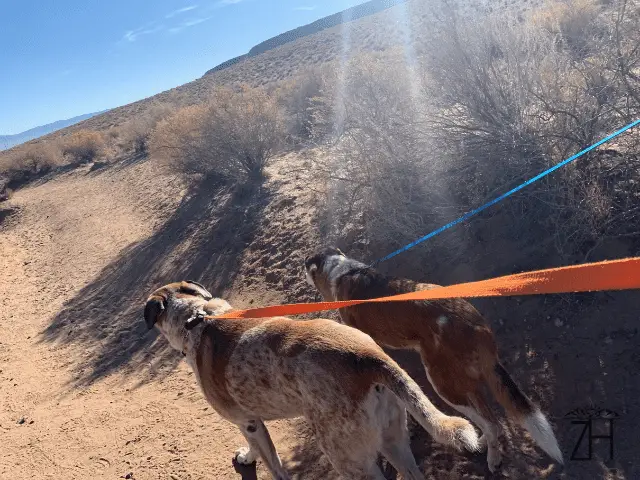How Long Is Too Long for a Day Hike With Your Dog?
Seasoned hikers can easily cover 25 to 30 miles on a day hike, with their dogs covering more off-leash. Dogs who aren’t used to long-distance walks can happily hike around 5 to 10 miles without feeling sore as long as they’re healthy and fit.
Keep in mind that dogs don’t have as much stamina as humans, so they probably can’t keep up that pace for multiple days in a row. “Don’t be a weekend warrior,” says Dr. Jen Pascucci, animal therapist and veterinarian. “Fitting in a week’s worth of exercise on the weekend isn’t good for dogs who aren’t used to such activity.”
Some dogs are just happy to spend time with their owners and will do anything to keep up with their pace. Their drive to work and play may force them to push through fatigue and potential injury. This is why owners should take responsibility and place boundaries to limit their dog’s high drive.
To determine how long is “too long,” you’ll first have to look at your dog’s age, breed, experience, and overall health.
If you don’t quite know how far your dog can go, start with an acceptable pace of 3 to 5 miles before increasing it with half-mile intervals after every session.
Keep a close eye on his physical state and make sure he gets sufficient breaks every so often. It might take several weeks to months to reach your dog’s full hiking potential, so don’t rush it to prevent soreness, injury, and exhaustion.
Factors That Contribute to Soreness in Dogs

Every dog is unique. Some dogs can hike up to 30 miles without breaking a sweat, while others refuse to take another step after 5. Here are some factors that may contribute to soreness in dogs after a hike.
Naturally, young pups and senior dogs aren’t as physically healthy as dogs between the ages of 2 to 8.
The former two can’t spend as much time on their feet.
Young pups, with their developing bones and small lungs, won’t be able to keep up with your long strides and stamina.
Senior dogs have weaker joints and other health problems due to age, making them more susceptible to soreness after hiking.
Our Chompers is now 16 years old (yes, 16!) and still LOVES to hike although we have to be more careful with how often and how far we hike with her now.
Some breeds are naturally used to strenuous physical activities. They were bred for long hours of work in rough weather conditions. For this reason, they rarely feel sore even after walking long distances.
Brachycephalic breeds like Pugs, Shih Tzus, and Boxers, aren’t suited for long-distance walks because they have weaker muscles and weaker lungs.
Dogs with short legs are also more likely to become sore after long hikes. Since they don’t cover as much ground as long-legged dogs, they’re putting more effort to keep up with your strides. This puts more strain on their muscles, resulting in pain and soreness.

Dogs who aren’t used to hiking are more likely to become sore than dogs who hike every week.
Like humans, dogs need to train their muscles for long-distance walks to lessen the amount of soreness they experience.
With regular activity, dogs can surpass a human’s pace with no issues. It just takes a bit of time and practice.
Just like with us, the harder and longer the hike, the more likely your dog will become sore.
Hiking in elevated steeps through dense vegetation is far more challenging and exhausting than hiking in flat, easy-to-travel terrains. Likewise, hiking 5 miles is a walk in the park compared to hiking 15 miles.
This is why you should always consider your dog’s hiking experience and health before taking on big trails.
Why is Your Dog Sore After a Hike?

Did you just wake up one day and decide to go on a 15-20 mile hike? Of course not! You have to slowly build-up mileage by going on lots of short hikes.
Dog’s muscles aren’t all that different from humans. You can’t expect a dog to just hop off the couch and exercise all day long without getting sore. It takes regular exercise and a healthy lifestyle.
So how far can a dog hike? It all depends on your dogs age, activity level and past hiking experience. A healthy dog that gets lots of exercise can usually hike 10-15 miles without getting sore. With regular training you can usually bump up the mileage to 20+ miles.
Just remember that not every dog is the same. You need to plan your hike around the dog. These are some of the factors that could affect your dogs soreness after a hike.
Day 74 Do Dogs Get Sore?
What is that one thing that you crave after a hike? A refreshing beverage? a bath? a nap? Do you ever bring your dog along? Ever wonder what s/he needs or wants afterwards?
A good long hike through nature can be a great source of therapeutic stress relief for us humans, and its nothing short of an unmitigated adventure for your canine companion.
While your dog may be perfectly content to lounge around and nap, as a responsible pet parent, its your job to check them over and care for them as needed.
The only question is, what should you do? What do you check, and what tools can you use to solve any little issues that crop up?
Given the low level of awareness on this topic, I decided to make this blog post some sort of a pet parents guide to caring for a dog after a hike.
In this guide I discuss practical and easy to follow tips every pet parent should follow to help re-set their dogs after a hike.
I have also included a very short video on water intoxication. Did you know there was such a thing ? This video is a must watch!
As usual my blog is packed with resources. For pet parents looking for more dog care guides, I have listed some great guides at the bottom.
First things first, before you plan any outings with your best friend, make sure s/he is fit for the challenge.
Water is essential to life. You probably work up quite a thirst while hiking and should carry enough water for a hike to keep yourself properly hydrated.
Running out of water can be surprisingly harmful, especially if youre hiking somewhere where its hot and sunny.
The same goes for your fur baby! No matter how adventurous your pup is, dogs still need plenty of water, which means you need to be carrying enough water for your pup too, and offer them plenty of water to rehydrate both during and when you get home from the hike.
Just make sure not to give them too much water too quickly. If your fur baby doesnt know when to stop, make sure to give them water slowly for the evening.
Did you know that too much water can be extremely dangerous to your dog? As it turns out, an imbalance in electrolytes can be extremely dangerous, and lead to water intoxication.
Dehydration followed by excessive water consumption can trigger it. Obviously, the goal is to not reach a dehydrated state, hence the breaks for water while hiking.
Additionally, you should always pay close attention to how your dog is behaving for up to 24 hours after a hike.
In addition to water intoxication, there are all sorts of things that can go wrong, from an allergic reaction to an animal bite to heatstroke.
According to Veterinary Partner, some allergic reactions to certain plants such as mushrooms can start as late as 10 – 12 hours after contact.
It might be very easy to think the symptoms are related to something your dog ate at home and forget about the possible connection with the hike thus narrowing the number of possible causes.
After a hike, you want to do your best to ensure your dog is just happy and tired, not hurt, and have an emergency plan in place if something goes wrong.